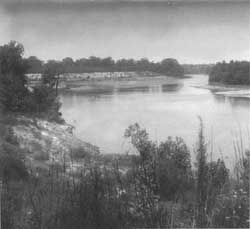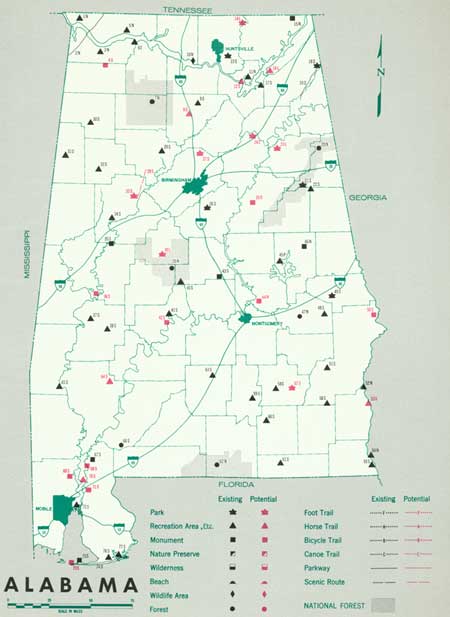.gif)
Parks for America
MENU
|
Parks for America
|

|
ALABAMA
ALABAMA lies partly in the Appalachian highlands and partly in the gulf coastal plain. The State's rich and varied resources include abundant fish and game, vast waterpower reserves, and extensive forests. These are resources that can contribute to diversified outdoor recreation.

|
| Fort Toulouse, at the confluence of the Coosa and Tallapoosa Rivers, served as the eastern outpost of French Louisiana from 1717 to 1763. The treaty ending the Creek War was signed at Fort Jackson, built on the site of old Fort Toulouse by Andrew Jackson in 1814. The site is a Registered National Historic Landmark. |
A 33-percent rise in urban population was recorded during the last decade, making the total population 3,266,740. This marked trend is expected to continue, bringing the State population to 3,575,000 by 1976. The population is over 54 percent urban and the average density is 64.0 people per square mile. Birmingham, Mobile, Montgomery, and Gadsden are centers of the most densely populated areas.
The tourist industry is beginning to take on statewide significance. In 1960 the industry had an estimated value of $130 million. Agriculture and industrial developments continue to provide the principal economic base, with Mobile, on the gulf coast, acting as an important deep-water terminal.
State and county highways provide access to all of the major developed recreation regions. The new Interstate System will bring the scenic mountain and gulf coast regions within weekend reach of many, and provide better access to a number of the existing parks and recreation areas.
The forested uplands and the gulf shore can provide ample opportunity for outdoor enjoyment.
Gradual variations in climate favor a long outdoor season. Coastal areas and the northern uplands are favorite retreats from prolonged heat spells. Numerous large water impoundments supplement the natural resources found in this State.
Historic interest centers on Spanish expeditions, early French settlements, and Civil War events. The Confederate Capitol in Montgomery, Fort Morgan in Mobile, and Fort Toulouse possess exceptional historical value.
Upland bird hunting is good and fishing excellent. Turkey hunting in the southwest has attracted national interest.
EXISTING PUBLIC AREAS
NATIONAL: The National Park Service administers a national military park, a national monument, and a national parkway (chiefly in Mississippi and Tennessee). They contain 3,313 acres, and the 1960 attendance was 23,300. The 4 national forests, totaling 631,029 acres, had an attendance of 199,000 in 1960. There are 99 acres in 26 developments for recreation use. The Bureau of Sport Fisheries and Wildlife administers one national wildlife refuge of 34,988 acres. Visits in 1960 amounted to 166,400. Two reservoirs (partly in adjacent States), with 83,500 water acres in Alabama, 40 access points, and a 1960 attendance of 1,034,000 are operated by the Corps of Engineers. The Tennessee Valley Authority administers 4 reservoirs (one partly in Tennessee) with 194,930 water-acres in Alabama, 59 access points, and a 1960 attendance of 17,314,700.
STATE: The Division of State Parks administers 35 parks and related areas, with a total of 43,479 acres. The 1960 attendance was 2,835,975. The Division of Forestry has eight forests, totaling 14,248 acres. One forest has two recreation areas. The Division of Game and Fish administers 30 areas for public hunting and fishing with a total of 5,333 acres. The Alabama State Highway Department administers eight roadside parks amounting to 16 acres.
The State park system, while reasonably well established, provides only 13 acres for each 1,000 people based on 1960 population. Even if ideally distributed and developed, this would serve only a fraction of the needs especially in the absence of major nonurban local parks. At present there is an unevenness in development and distribution of the areas in the State system. Also, more emphasis to historic and archeologic sites and preservation of natural features is desirable. Potential areas identified in this plan as being of State significance total 18,935 acres, and those of local significance amount to 3,040 acres. Additional areas will be needed to meet the demand by 1976.
RECOMMENDATIONS
Fort Toulouse, at the confluence of the Coosa and Tallapoosa Rivers, served as the eastern outpost of French Louisiana from 1717 to 1763. The treaty ending the Creek War was signed at Fort Jackson, built on the site of old Fort Toulouse by Andrew Jackson in 1814. The site is a Registered National Historic Landmark.
LOCAL: There are no significant nonurban local areas.
PRIVATE ENTERPRISE: An increasingly important role is being played by private enterprise in providing visitor accommodations and facilities along the gulf coast and at large reservoirs.
Industry and a private power company have in one instance worked together to create a recreation area on a previously undeveloped lakeshore.
PARK AND RELATED NEEDS
The significant upward trend of urban population accentuates the urgency for more day-use facilities near metropolitan centers and to a lesser degree near the smaller cities and towns. Acquisition for park purposes of additional gulf coast frontage and lands adjoining major reservoirs is of paramount importance.
Existing recreation resources and many potential areas are shown on the accompanying tabulation and map. Vigorous action on the part of the agencies concerned is urged to secure needed outdoor recreation opportunities for public enjoyment and use. To help achieve this important goal, the following recommendations are offered.
NATIONAL: Give further study toward establishment of Fort Toulouse as a national monument.
STATE: Enlarge the State park system to protect significant resources by addition of four recreation areas and five monuments. It is suggested that there be further study of eight areas.
LOCAL: Establish one recreation area, and give further study to four suggested areas.
Supporting recommendations include—
1. Investigation of the feasibility of expanding recreational opportunities at State-managed public fishing lakes.
2. Provision for additional waysides along major highways and establishment of a system of scenic roads that will permit leisurely enjoyment of the landscape.
(Table omitted from online edition)

|
| (click on image for an enlargement in a new window) |
NEXT >>>
|
|
Last Modified: Mon, Sep 6 2004 10:00:00 pm PDT
parks_america/alabama.htm
 Top
Top